The Settlers of Catan was one of the first games I played that inspired me to do what I do today…write reviews and help spread awareness of games that a lot of families may not of even heard of. For those of you who haven’t played The Settlers of Catan or read my review, it’s a game that tasks players with earning resources and building settlements and roads with the goal of earning ten victory points. There’s a bit more to it than that, especially when trading resources and the thief is involved…if you want to read more about it, you can check out my review of The Settlers of Catan here: The Settlers of Catan Review.
*Editor’s Note: The Settlers of Catan and Star Trek Catan both mention on their boxes that you need three or four players to play, but I know plenty of people who play with two, right out of the box, without a problem. There are also variants available on the web to make your two player game more interesting.
Star Trek Catan plays very similarly to The Settlers of Catan, except for maybe a few small differences. Players will still be collecting resources and using said resources to expand their network…though settlements, cities, and roads now become outposts, starbases, and starships, respectively. Let’s take a quick look at what came in the box and how the game is played before heading into the review.
Components
Sector Tiles – Most sector tiles have a single planet on them, though there is one that sports an asteroid field. The color of the planet indicates what resources can be earned. Those who have played the original game will know them as terrain hexes.
Number Tokens – Number tokens are placed on sector tiles after they are laid out on the table. They assign a tile (or planet) a number…when that number is rolled, that planet yields its resource to any bordering outpost or starbase. They function the same way as in the original game.
Frame Pieces – The frame pieces are positioned along the outside of the board and list trading posts on them. They are used primarily for when a player wishes to trade resources with the bank. Those who have played the original game will know them as frame pieces as well, but they will sport trading posts instead of harbors.
Resource Cards – Players earn resource cards as planets yield them from turn to turn. Red planets yield tritanium, yellow planets yield food, white planets yield oxygen, green planets yield dilithium, and blue planets yield water. Those who have played the original game will recognize that these cards replace their lumber, coal, ore, grain, and wool counterparts.
Development Cards – Development cards can be acquired by trading in the appropriate amount of resources. They are made up of Starfleet Intervenes cards, Progress cards, and Victory Point cards. Those who have played the original game will find that these cards replace the development cards used there, their effects for the most part being roughly the same.
Support Cards – Each support card lists a character from the Star Trek universe and a special ability. Players will be able to use these abilities throughout the game and swap cards out from the pool from turn to turn. Support cards have an “A” side and a “B” side, though the abilities listed on both sides are the same. When players acquire a new support card, they start on side “A”. When they use it, they can either flip it to side “B” or swap it out with a new support card. When a player uses the “B” side, they must swap that card with one from the pool. This is the one feature that I could not relate the original game to.
Building Costs Cards – Each player receives one of these. They act as player guides and remind players on how much certain items cost. They function like the building costs cards found in the original game.
Special Cards – The Longest Supply Route card is awarded to players throughout the game as they continuously outdo one another in forming the longest chain of starships. The Largest Starfleet card is awarded to players throughout the game as they continuously outdo one another in playing Starfleet Intervene cards. They are the equivalent of the Longest Road and Largest Army cards in the original game.
Game Pieces – Each player will have a set of starships, outposts, and starbase expansions of their color which they will use during the game to build their network. The Klingon battle cruiser piece acts as the thief like in the original game, moving around the board and stopping players from collecting resources, among other things.
Setup & Gameplay
The game can be setup in a pre-set order as found in the rulebook, or experienced players can set up the board how they’d like using the variable setup rules found in the accompanying almanac. Experienced Catan players need not worry…they can randomize tiles, frame pieces, number chits, and other things to their heart’s content. I won’t go into the entire setup procedure, but suffice it to say that each player will choose a colored set of pieces, arrange the board appropriately, and set the cards off to the side in their respective decks. I’ll link the manual later on in case you’d like to see more of that process.
On a player’s turn, they perform the following actions:
1) Roll for resource production: The player will roll two dice. The planets with number tokens on them that correspond to the dice roll total will yield a resource to ALL players with an outpost or starbase in orbit (or bordering that tile). If players roll a seven, they instead can move the Klingon battle cruiser to a hex of their choosing. Before that happens, all players must discard half of their resource supply to the bank if they have more than seven cards. Once the player moves the Klingon ship, they steal one random resource from players who have an outpost or starbase there. The Klingon ship stops resource production on that planet until it moves away to another hex.
2) Trade: Trading is optional. The player is free to trade openly with any other player or with the bank. Trading with the bank defaults in a 4:1 relationship…that is…if they want one oxygen, they must give the bank four of another resource. Players can offset this harsh trade ratio by having an outpost or starbase next to a trading post (on the frame pieces)…those ratios are 3:1 and 2:1. First time players should take care to remember that the 2:1 trading posts list a particular resource. Players can only trade in that resource, but can receive one of any resource as normal at a 2:1 rate.
3) Build: The player can build or purchase a number of things, if they’d like, by trading in the appropriate resource cards to the bank. There are certain rules in regards to starship and outpost placement, but they ultimately serve to award players victory points so that they can win the game. In addition to placing starships and outposts, players can upgrade their outposts to starbases and buy development cards.
4) Use Support Card: Depending on the card itself, the player will be able to utilize specific abilities. Not all cards are played at the same time and can only be played twice before they must be swapped with another from the pool. Players can choose to swap it with another from the pool after using it only once. It’s important to note that these cards can’t be used in the same turn in which they were acquired.
Players continue taking turns and expanding their networks until one player has reached ten victory points. Victory points are awarded in real-time as the game goes on…so a player’s score can increase or decrease on a whim, depending on the situation. If a player owns the Largest Starfleet card for example and another player one-ups them, the card changes hands and both players’ scores are affected appropriately.
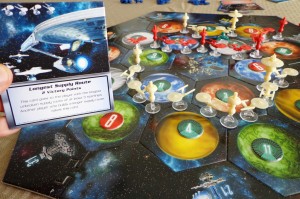
Having the most starships in a chain will net you the Longest Supply Route card and two victory points!
The above is simply an overview of the game, but should give you an idea of how it is played. To see the rules in greater detail, please check out the manual and almanac, located here:
The Review
First, let’s touch on the components. One of the main reasons I don’t play the original as much as I do is because of the warped harbor frame pieces…it can be discerning when the pieces to a game you purchase don’t fit together right. I didn’t have that issue in Star Trek Catan, which will certainly increase the amount of the time it sees outside of my cupboard. The components are well done and work nicely together…they also definitely keep well with the Star Trek theme. On top of that, they are beautiful to look at!
In terms of gameplay, the original plays almost identically to Star Trek Catan, though the addition of the support cards adds a nice twist to the game. Experienced players of the original will be able to jump right in to Star Trek Catan without any issues. New players and/or casual gamers may find the rules intimidating at first, though the manual and the accompanying almanac do a good job in explaining the rules and the components. Still, new players should set aside some extra time to get used to the game and its learning curve. The beginner setup rule set should introduce players nicely as they won’t have to worry about randomizing tiles and initially placing their outposts and starships.
Strategy is still just as important as it was in the original. Due to the laws of statistical probabilities, some numbers have a chance of being rolled more than others…this means that players will be strategically placing their outposts and starbases to maximize their resource collection. Having five different resources available also means that players might see a lot of one resource but not so much of another, making trading an important part of the game. As important as it is to place your outposts in ways that might set you ahead, it’s also important to know how to haggle as the bank can be a rip-off, even at the 2:1 trade ratio. Younger children may have an issue with the social aspect of trading and haggling for things they need…though with the right coaching from parents, will adapt quickly.
Vinnie (11) was one such example as to someone who hadn’t learned the fine art of haggling yet. I took time out of the game when such situations arose to walk him through the process and to teach him the value of not losing more in the trade than he’d gain. Sometimes he would offer two or three resource cards for one…so as not to discourage him later on, I rejected the deal and showed him a more reasonable 1:1 that would work well for the both of us. As he gets better at it, I’ll loosen the reigns a bit and let him see the consequences of offering too much. He seemed a lot more involved in buying development cards whereas I stuck mainly to building outposts and upgrading them. It was interesting to watch as both approaches scored us both points in different ways.
Anthony (16) rounded off our group of three and was much more engaged in building outposts in strategic places. He had fun with the statistical aspects of rolling the dice and avoided building near numbers like two and twelve. This resulted in the two of us often fighting for position near some of the more popular planets where the numbers were better, like six and eight. He was playing with his usual vigor and built starships and outposts like no one’s business. In the end, all three of us were very close in score, but I pulled ahead at the last minute with a Longest Supply Route card and a Starbase upgrade.
Overall, Star Trek Catan is a great game. The only thing stopping me from recommending it fully is it’s $50.00 price tag (as of 9/15/12 at Target). If you are content with the original game and don’t need a Star Trek version of Catan, then you can save your money. If you’re a big Star Trek fan and HAVE to have everything with the Star Trek name on it (*whistles innocently*), then it will function well for you. I personally like it over the original because of the support cards and because of the quality of the components…as I mentioned earlier, the harbor pieces on the original game were warped to the point where playing the game became more of an annoyance than a joy. You’ll have to ultimately decide if $50.00 is too much to spend in this economy based on your financial situation and whether or not the original Catan suits your needs fully.
Final Verdict: 9/10
—

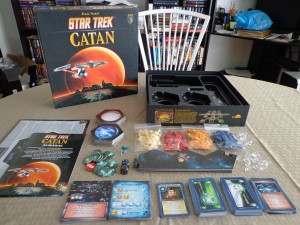
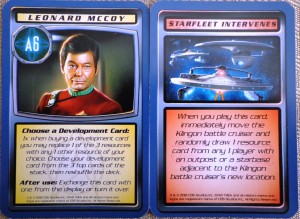
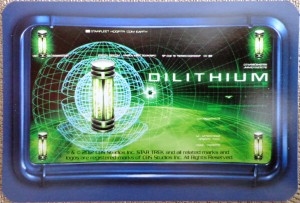
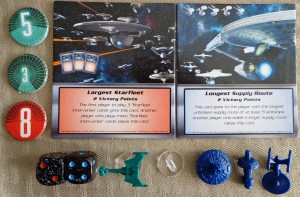
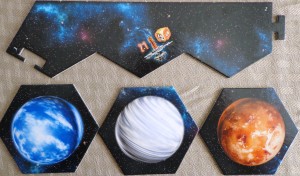
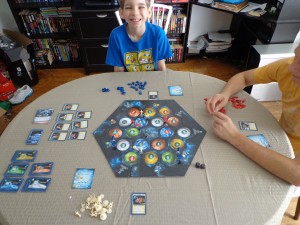
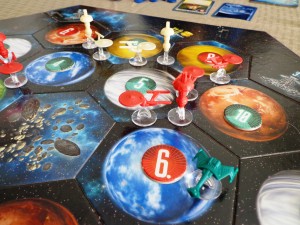
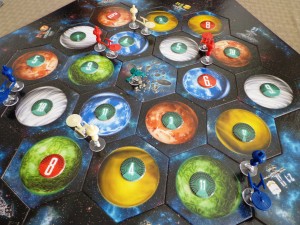
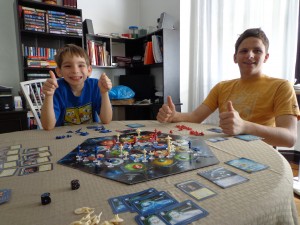
This is a vicious game. Many of the support cards allow you to mess with your opponents so hopefully everyone you play with is a good sport when it comes to winning and losing. Also, there is a high barrier to entry, even for experienced Catan players, just because they are constantly asked to review all the support cards and make a decision as to which one is best for their current situation. This leads to long play times for those who have not played much of this version.